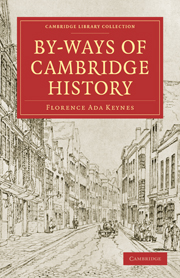Book contents
- Frontmatter
- PREFACE
- Contents
- ILLUSTRATIONS
- Introductory
- Chap. I The Guildhall and the Market Place
- Chap. II The Office of High Steward of the Borough of Cambridge
- Chap. III Cambridge Waits and Orlando Gibbons
- Chap. IV Barnwell Priory and the Old Abbey House
- Chap. V Why Oxford comes First. A Problem in Precedence
- Chap. VI Damaris Cudworth.—A Cambridge Woman of the Seventeenth Century
- Chap. VII A Town Plan for Cambridge in the Eighteenth Century
- Chap. VIII Mendicity House. Sidelights on Social Conditions in Cambridge in the Nineteenth Century
- Appendix: ‘Cambridge’ as a place-name
- Index
- Plate section
Chap. II - The Office of High Steward of the Borough of Cambridge
Published online by Cambridge University Press: 07 September 2010
- Frontmatter
- PREFACE
- Contents
- ILLUSTRATIONS
- Introductory
- Chap. I The Guildhall and the Market Place
- Chap. II The Office of High Steward of the Borough of Cambridge
- Chap. III Cambridge Waits and Orlando Gibbons
- Chap. IV Barnwell Priory and the Old Abbey House
- Chap. V Why Oxford comes First. A Problem in Precedence
- Chap. VI Damaris Cudworth.—A Cambridge Woman of the Seventeenth Century
- Chap. VII A Town Plan for Cambridge in the Eighteenth Century
- Chap. VIII Mendicity House. Sidelights on Social Conditions in Cambridge in the Nineteenth Century
- Appendix: ‘Cambridge’ as a place-name
- Index
- Plate section
Summary
WHEN Cambridge, in March 1943, elected a new High Steward of the Borough, many questions were asked about the duties, if any, of this officer and the origin and history of the office, questions to which no ready answers could be given. The following notes have been put together with the object of providing a sketch of the medieval background of the office which does not itself appear in English municipal life until the close of the Middle Ages. To this has been added a brief account of the holders of the office in Cambridge to the present day.
The development of the story involves a tentative inquiry into the constitution of the medieval borough in some of its aspects, an inquiry which to be successful would call for ‘a very perspicacious Person who hath an intuitive Soul’—to quote the words of an anonymous writer of the seventeenth century. ‘We shall have to think away distinctions that seem to us as clear as the sunshine; we must think ourselves back into a twilight.’ ‘Each town has its history, and makes its independent contribution to Municipal History as a whole’—a challenge to every municipality to trace its own history before the trail is lost.
- Type
- Chapter
- Information
- By-Ways of Cambridge History , pp. 21 - 56Publisher: Cambridge University PressPrint publication year: 2009First published in: 1947

